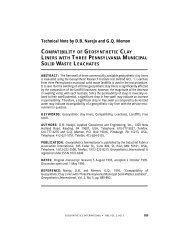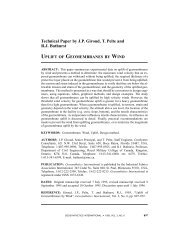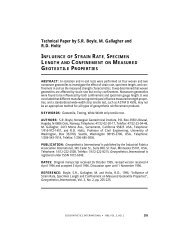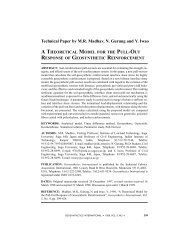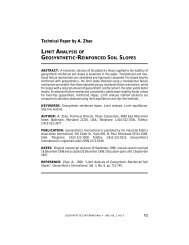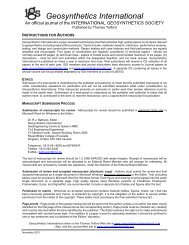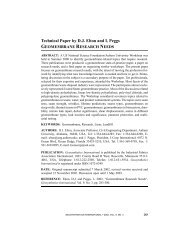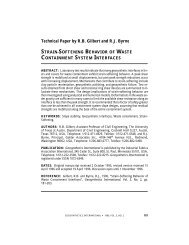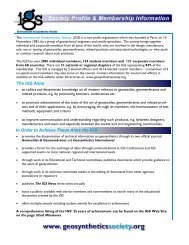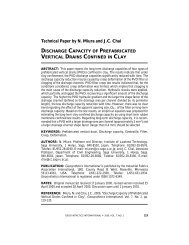Technical Paper by JP Giroud, KL Soderman and K. Badu-Tweneboah
Technical Paper by JP Giroud, KL Soderman and K. Badu-Tweneboah
Technical Paper by JP Giroud, KL Soderman and K. Badu-Tweneboah
You also want an ePaper? Increase the reach of your titles
YUMPU automatically turns print PDFs into web optimized ePapers that Google loves.
GIROUD et al. D Optimal Configuration of a Double Liner System<br />
B =<br />
q<br />
k tanb<br />
g L<br />
1 2<br />
(8)<br />
C =<br />
Q2<br />
aq<br />
1<br />
(9)<br />
Equation 6, like Equation 5, must be solved iteratively. However, Equation 6 is slightly<br />
more convenient than Equation 5 due to the use of dimensionless parameters <strong>and</strong> the<br />
availability of a graphical solution given in Figure 13 of the paper <strong>by</strong> <strong>Giroud</strong> et al.<br />
(1997b). In the comparative study presented in Section 3, the rate of leachate migration<br />
through the geomembrane secondary liner is calculated <strong>by</strong> solving Equation 6 iteratively<br />
for C <strong>and</strong>, then, using the following equation derived from Equation 9:<br />
Q<br />
= C a q<br />
2 1<br />
(10)<br />
The value of Q 2 thus obtained is then checked using Equation 5 with q i = q 1 , k = k 2<br />
<strong>and</strong> Q = Q 2 .<br />
2.3.5 Rate of Leachate Migration Through a Geomembrane Defect in a Composite<br />
Liner<br />
The rate of leachate migration through a composite liner, due to one defect in the geomembrane<br />
component of the composite liner, is calculated using the following equation<br />
(<strong>Giroud</strong> 1997):<br />
Q<br />
L F<br />
= 021 . 1+ 01 .<br />
H G<br />
NM<br />
h<br />
t<br />
s<br />
I<br />
KJ<br />
095 .<br />
O<br />
QP<br />
a h k<br />
01 . 09 . 074 .<br />
s<br />
where: t s = thickness of the soil component of the composite liner; <strong>and</strong> k s = hydraulic<br />
conductivity of the soil component of the composite liner.<br />
Equation 11 is the latest development of the work on the evaluation of leachate migration<br />
through composite liners initiated <strong>by</strong> <strong>Giroud</strong> <strong>and</strong> Bonaparte (1989) <strong>and</strong> continued<br />
<strong>by</strong> <strong>Giroud</strong> et al. (1989, 1992).<br />
(11)<br />
3 COMPARATIVE STUDY<br />
3.1 Presentation of the Comparative Study<br />
The two double liner systems that are used in the comparative study are shown in Figure<br />
2. Values of the relevant parameters are as follows:<br />
S The primary leachate collection layer material is gravel with a hydraulic conductivity,<br />
k 1 , greater than 0.1 m/s <strong>and</strong> a thickness sufficient to contain the maximum considered<br />
leachate head (0.1 m).<br />
380 GEOSYNTHETICS INTERNATIONAL S 1997, VOL. 4, NOS. 3-4



